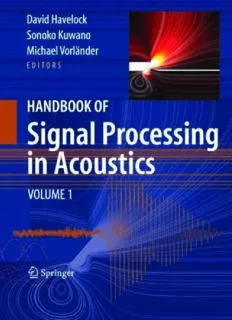Table Of ContentHandbook of Signal
Processing in Acoustics
Volume 1
Edited by
David Havelock
National Research Council, Canada
Sonoko Kuwano
Osaka University, Japan
¨
Michael Vorlander
RWTH Aachen University, Germany
Handbook of
Signal Processing
in Acoustics
Volume 1
123
Editors
DavidHavelock SonokoKuwano
NationalResearchCouncil OsakaUniversity
InstituteforMicrostructural GraduateSchoolofHuman
Sciences Sciences
AcousticsandSignal DepartmentofEnvironmental
ProcessingGroup Psychology
1200MontrealRoad 1-2YamadaokSuita
OttawaONK1A0R6 Osaka
Canada Japan
MichaelVorla¨nder
RWTHAachenUniversity
InstituteofTechnicalAcoustics
Aachen
Germany
ISBN:978-0-387-77698-9 e-ISBN:978-0-387-30441-0
LibraryofCongressControlNumber:2008923573
©2008SpringerScience+BusinessMedia,LLC
All rights reserved. This work may not be translated or copied in whole or in
partwithoutthewrittenpermissionofthepublisher(SpringerScience+Business
Media, LLC, 233 Spring Street, New York, NY 10013, USA), except for brief
excerptsinconnectionwithreviewsorscholarlyanalysis.Useinconnectionwith
any form of information storage and retrieval, electronic adaptation, computer
software, or by similar or dissimilar methodology now known or hereafter
developedisforbidden.
Theuseinthispublicationoftradenames,trademarks,servicemarks,andsimilar
terms,eveniftheyarenotidentifiedassuch,isnottobetakenasanexpression
ofopinionastowhetherornottheyaresubjecttoproprietaryrights.
Printedonacid-freepaper
987654321
springer.com
Editor Biographies
David Havelock
National Research Council
Institute for Microstructural Sciences
Acoustics and Signal Processing Group
1200 Montreal Road
Ottawa ON K1A 0R6
Canada
Sonoko Kuwano
Osaka University
Graduate School of Human Sciences
Department of Environmental Psychology
1-2 Yamadaok Suita
Osaka
Japan
Michael Vorla¨nder
RWTH Aachen University
Institute of Technical Acoustics
Aachen
Germany
Editorial Board
LastName GivenName(s) Affiliation/Address
Beauchamp JamesW. UniversityofIllinoisUrbana-Champaign,
SchoolofMusic,Dept.ofECE,
Urbana,IL,USA
Christie DouglasR. Earth Physics, Research School of Earth
Sciences,TheAustralianNationalUniversity,
Canberra,AUSTRALIA
Deffenbaugh Max ExxonMobil Research and Engineering
Company,Annandale,NJUSA
Elliott StephenJ. SouthamptonUniversity,InstituteofSoundand
VibrationResearch,Southampton,ENGLAND
Fastl Hugo TechnischeUniversitaetMuenchen
AGTechnischeAkustik,MMK
Muenchen,GERMANY
Gierlich HansWilhelm HEADacousticsGmbH
TelecomDivision,Herzogenrath,GERMANY
Guyader Jean-Louis LabratoryforVibrationAcoustics
Villeurbanne,FRANCE
Jacobsen Finn TechnicalUniversityofDenmark,
Lyngby,DENMARK
Karjalainen Matti HelsinkiUniversityofTechnology,FINLAND
Kollmeier Birger UniversitatOldenburg,Oldenburg,GERMANY
O’Shaughnessy DouglasD. INRS-EMT(Telecommunications),Montreal,
QC,CANADA
Riquimaroux Hiroshi DoshishaUniversity,DepartmentofKnowledge
Engineering&ComputerSciences,Sensory&
CognitiveNeuroscienceResearchLaboratory,
Kyotanabe,Kyoto,JAPAN
Sullivan EdmundJ. EJSConsultantsPortsmouth,RI,USA
viii EditorialBoard
LastName GivenName(s) Affiliation/Address
Suzuki Hideo 1-2-3-S2502,Utase,Mihama-ward,Chiba-city,
JAPAN261-0013
Taroudakis Michael UniversityofCreteDepartmentofMathematics,
and FORTH, Institute of Applied and
Computational Mathematics, Heraklion,
GREECE
Ueha Sadayuki Tokyo Institute of Technology, Director,
PrecisionandIntelligenceLab,Yokohama,
JAPAN
Verrillo RonaldT. (deceased)
InstituteforSensoryResearch,Syracuse,NY,
USA
Yamada Ichiro AviationEnvironmentResearchCenter,Airport
EnvironmentImprovementFoundation,Tokyo,
JAPAN
Yamasaki Yoshio WasedaUniversity,GraduateSchoolofGlobal
InformationandTelecommunicationStudies,
Saitama,JAPAN
Tohyama Mikio WasedaUniversity,JAPAN
Preface
Acousticshasaspecialrelationshipwithsignalprocessing.Many
concepts in signal processing arise naturally from our general
experience with sound and vibration and, more than in many
otherfields,acousticsisconcernedwiththeacquisition,analysis,
and synthesis of signals. Consequently, there is a rich resource
of signal processing expertise within the acoustics community.
There are many excellent reference books devoted to signal
processingbuttheobjectiveoftheHandbookofSignalProcessing
in Acoustics is to bring together the signal processing expertise
specific to acoustics and to capture the interdisciplinary nature
of signal processing within acoustics. It is also hoped that the
handbookwillpromotenetworkingandtheinterchangeofideas
between technical areas in acoustics.
Thehandbookcomprises104Chaptersorganizedinto17Parts.
Each Part addresses a technical area of acoustics, reflecting
the general demarcations of specialization within the acoustics
community.Anexpertwithbroadknowledgeofsignalprocessing
within their respective technical area was invited to act as a
Section Leader for each Part of the handbook. These Section
Leaders contributed substantially to the handbook project by
helpingtodefinethecontentsandscopeofeachchapter,finding
an appropriate contributing expert author, and managing the
review and revision of material. Collectively with the Editors,
they form the Editorial Board for the handbook.
Planned sections on Architectural Acoustics, Nonlinear
Acoustics, and Ultrasound are unfortunately omitted from
the handbook; nevertheless, the handbook otherwise provides
thoroughcoverageofthefieldofacousticsandwecanhopethat
possible future editions might include these areas.
The handbook is written from the perspective of acoustics, by
acousticianswithsignalprocessingexpertise.Emphasisisplaced
x Preface
inthedescriptionofacousticproblemsandthesignalprocessing
related to their solutions. The reader is assumed to have basic
knowledgeofsignalprocessing.Signalprocessingtechniquesare
describedbutthereaderisreferredelsewhereforderivationsand
details.
The authors were not required to adhere to strict standards
of style or notation, and were asked to prepare short, concise,
self-sufficient chapters. This results in variations in style and
notation throughout the handbook that reflects the diversity of
perspectives within the acoustics community.
David Havelock
Acknowledgments
David Havelock gratefully acknowledges support from the
Institute for Microstructural Sciences, of the National Research
Council of Canada, for making time and resources available
duringthepreparationofthishandbook.HealsothanksJohnC.
Burgess(UniversityofHawaii,retired)fortheencouragementto
begin this project and expresses his gratitude to the co-Editors,
Sonoko Kuwano and Michael Vorla¨nder, who were a pleasure
to work with throughout this project. The efforts of all of the
Section Leaders are greatly appreciated and we thank each of
them sincerely for their patience, perseverance, and faith that
were required to see this project to completion. We thank each
of the authors for their contributions.
Description:The Handbook of Signal Processing in Acoustics brings together a wide range of perspectives from over 100 authors to reveal the interdisciplinary nature of the subject. It brings the key issues from both acoustics and signal processing into perspective and is a unique resource for experts and practi

